#Eugenic Protection Law
Explore tagged Tumblr posts
Text
Some people like eugenics even if they are not far-right (Essay)

Shizue Kato(A left-wing female lawmaker)
Eugenics started in the USA and is famous for being adopted by far-right Nazi Germany. They used it as a standard for ethnic cleansing and carried out a large-scale genocide of the Jews.
You might think this was before WW2, but it was enacted in Japan after WW2. It was the "Eugenic Protection Law." This law took away the reproductive functions of disabled people without their consent, robbing more than 16,000 people of their futures.
The people who worked to enact this evil law were female Diet members Shizue Kato and Masako Fukuda, who gained the eligibility to be elected after WW2. They belonged to the left-wing Socialist Party!!
They were elected with the support of GHQ, which ruled Japan, and this law took away Japan's vitality. The birth control movement was their starting point, but they ended up stepping into the demonic work of sterilizing disabled people, which was originally unrelated to them.
As a result, the "baby boom" ended, and Japan later fell into a society with a declining birthrate and an aging population. If you create a legal system that makes it easy for grandparents to erase their grandchildren, that's the result. I have to say that the left-wing female lawmakers were very shallow and stupid.
Rei Morishita
2024.05.30
極右でなくても優生学が好きな連中がいる(エッセイ)
優生学はUSAで始まり、極右のナチス・ドイツが採用したことで有名である。民族浄化を行う基準として使い、ユダヤ人虐殺を大いに行った。
これがWW2前の話かと思うと、そうではなく、WW2後の日本で法制化された。「優生保護法」である。この法律は障害者から本人の同意なく生殖機能を奪い、都合1万6千人以上の将来を奪った。
この悪法を制定するために動いたのは、WW2後、参政権を得た女性国会議員の加藤シズエ、福田昌子などだった。彼女たちは、左翼の社会党に所属していた!
彼女らは、日本を支配していたGHQの後押しで当選したが、この法律は日本の活力を奪った。産児制限運動が彼女らの出発点だったが、本来無関係であった障害者の断種という悪鬼の所業に踏み込んでしまったのだ。
結果、それまでの「ベビーブーム」は終息し、のちに日本は少子高齢化社会に落ち込む。祖父・祖母が孫を欲しがらぬことを手助けする法制度を作れば、結果はそのようになる。なんとも浅はかで愚かな左翼女性議員たちだったと言わざるを得ない。
#eugenics#essay#rei morishita#far-right#Shizue Kato#Nazi Germany#Japan#Eugenic Protection Law#left-wing#Socialist Party#baby boom#female lawmakers#erase
13 notes
·
View notes
Text
Ethnic cleansing? Genocide? Apartheid?
Throwing around these buzzwords to describe the Israel-Hamas war because you’ve seen them on social media doesn’t make you right, and it doesn’t make you an activist.
It makes you ignorant, intellectually dishonest, and lazy for parroting biased talking points with no concept about what these terms actually mean.
What is apartheid?
Well, it was first used to describe the political system in South Africa and today’s Namibia whereby racism was institutionalised. This manner of governance meant that clear racial segregation would occur, in a manner that benefited the white race and would actively oppress those who had darker skin.
This meant that there were white-only spaces, white people would get prioritised when it came to education and jobs, and relationships/marriages between white peoples and coloured people were illegal.
Is Israel objectively an apartheid state? There are no laws that actively favour one group over the other. There is a sizeable population of Israeli Arabs that can thrive in the same way as the Israeli Jews can. There are laws against discrimination on the basis of gender, race/ethnicity, and sexual orientation.
Palestinians from Gaza are allowed to work in Israel through a work permit system. There are about 150,000 Palestinians working in Israel, most of which live in Israel and some come from Gaza/the West Bank. They aren’t denied rights institutionally.
Is it harder to get a job or education in Israel if you’re a Palestinian from Gaza? Sure, because of different governments. It’s like how it’s a lot easier for you to find a job in your own country (in terms of paperwork and bureaucracy) than overseas. But you’re not denied the right to apply.
Of course, if you have a history of violence, a criminal record, or your family has ties to terrorists, then it’ll be a lot harder to get an approved work permit. But that’s not apartheid. That’s common sense, and a regulation practiced by all countries that minimally desire to protect their own population from danger.
Ethnic cleansing and genocide
These two concepts can go hand-in-hand. Ethnic cleansing refers to the mass expulsion or killing of a group of people based on their ethnicity. Similarly, genocide is the purposeful killing of a group of people solely with the intention of annihilating them.
Famous examples? The Holocaust, of course, where the Nazi regime believed in the superiority of the Aryan race and decided to declare genocide on the Jews, Romanis, the LGBTQ+ community, people with disabilities, people with “Asian features”, and many many other groups. Anyone who they didn’t think was “pure”.
Their aim was to ensure that the Aryan race propagated without having “impure” blood affecting the bloodlines. They even started a eugenics programme called Lebensborn to ensure that more pure Aryan babies were born.
More recent examples? The Rwandan genocide where the Hutus attempted to wipe out the Tutsis on the basis of ethnicity. They mandated that Tutsis mention their ethnicity on state-issued ID cards in order for the Hutus in power to be able to identify them and then kill them.
Or the Yazidi genocide which happened so recently, in which ISIL killed, raped, and sent thousands of Yazidis into conversion camps on the basis of their ethnicity. They also took Yazidi women as sex slaves and raped and tortured them.
Or the Rohingya Muslims in the Rakhine State in Myanmar, and how there was a mass killing and expulsion of them from the country, forcing them to flee to Bangladesh to take refuge, crating the world’s largest refugee camp.
Or how ISIS killed thousands of people from Christian groups in Iraq, Syria, Egypt, and Libya because of their faith, leading the US, EU, and UK to label this as religious genocide and condemned their actions.
Has Israel been practicing ethnic cleansing and genocide on Palestinians all these years?
Well, the birth rate of the Palestinian population in Gaza, the West Bank, and in Israel has been steadily increasing all these years.
So, no. No ethnic cleansing, no genocide. They are free to have as many children as they desire.
The UN Genocide Convention
The United Nations has 5 actions that constitute genocide.
1. Killing members of a target group
Israel is targeting Hamas officials with the aim of wiping out the terrorist group and ensuring that such a deadly attack on Israeli soil doesn’t happen again. I suppose you could call it genocide against Hamas, but they’re killing Hamas because they’re terrorists, not because they’re Palestinian. Shouldn’t everyone believe in genocide against terrorists?
But look at Black Saturday. Look at Hamas’ rhetoric. They repeatedly call for the annihilation of Israel and genocide of Jews. When will the media start believing what they say, word for word, instead of trying to spin it into “hmm maybe they want to kill all the Jews because they’re freedom fighters!”
War has collateral damage. Of course the innocent civilians don’t deserve to suffer just because of the actions of their government, but there have been warnings given to the Palestinian civilians prior to Israel striking the areas. There are consequences of attacking a country first, and then having that country attack you back.
2. Causing people of the group serious bodily or mental harm
The UN refers to sexual violence as the prime example of non-fatal harm.
Sexual violence has occurred. Hamas have kidnapped and raped women and even paraded the bodies of half-naked women around. But I f Israel had done the same, it’ll be the first thing appearing on everyone’s BBC push notifications (without even being confirmed as true).
3. Imposing living conditions intended to destroy the group
Many people refer to the blockade that Israel imposed around the Gaza Strip as an example of this.
This blockade was imposed by both Israel and Egypt in 2005. Its aim was to prevent smuggling of weapons into Gaza, and isolate the reign of Hamas to the region. This was to ensure the safety of Israel and Egypt.
Did this blockade pose serious challenges to the Gazan civilians? Of course. But that’s a consequence of having a terrorist government. If you have a terrorist group running your country, don’t be surprised if neighbouring countries are extra careful about who or what they allow in or out of the borders.
Many authorities from other Arab nations have also expressed approval of Egypt’s border restrictions, and even encouraged Egypt to flood the terror tunnels that Hamas has dug under the city. As a side note, other Arab nations have not historically been very kind or welcoming to Palestinians. Syria has killed over 4000 Palestinians, and many Arab countries are now refusing any refuge for Palestinians. But no one cares about that because it doesn’t make Israel look bad. All they do now is use the images of dead Palestinians under the hands of Syria and reuse them to propagate fake news.
The blockade has been labelled as a human rights violation because of collective punishment. Many humanitarian organisations believe that the blockade has caused the Palestinian civilians disproportionate harm.
Contrary to popular belief, Israel isn’t disallowing humanitarian aid from coming through the borders. Fuel, food, hygiene products, clothes, and shoes have been coming through the borders regularly for years. The Gaza Strip also has electricity and internet access and water.
Do all these items reach the Palestinian civilians? Well, there has been evidence that Hamas has been intercepting a lot of the supplies sent by humanitarian groups. This is not surprising since the UNRWA tweeted that Hamas has stole fuel from hospitals in Gaza in order to launch more rockets at Israel (but quickly deleted it after realising that it goes against their agenda to paint Hamas in a bad light.) In addition, the returned hostages have mentioned that there are many aid supplies hidden in the terror tunnels by Hamas. Instead of giving them to the civilians, they are hoarding it for themselves.
There has also been video evidence that some people are reselling these aid items in stores at exorbitant prices in order to turn profits. This has been well-documented for the last 10 years.
Is blockading the region to mitigate terrorism a disproportionate response? Well, it’s like asking if heightened security and stricter border control at airports is a disproportionate response after 9/11. Is being cautious and worrying about the security of your country an irrational reaction to the constant threat of terrorism?
4. Preventing births
Gaza’s population growth rate per annum is about 1.99%, which is the 39th highest in the world! Their population is allowed to propagate freely.
Israel isn’t preventing births of Palestinian babies.
5. Forcibly transferring children out of the group
No, Israel hasn’t been taking Palestinian children and forcing them to convert/keeping young Palestinian girls as sex slaves. Like I said, if this was truly happening, all the news outlets would be so quick to publish the story before verifying it.
Can we trust the UN Genocide standards?
The UN is known for corruption and have been exploiting the Palestinian people by selling them the humanitarian supplies instead of distributing them for free, which they should because these supplies literally are donations.
The UN also has differing standards of what they would label as genocide. For example, they refuse to call what China is doing to the Uyghurs in Xinjiang as genocide, even though the situation does fit many of their own criteria.
Hence, to all of you out there overusing these terms without knowing what they mean, make up your own mind about things. No one can force you to believe anything and no one can force you to change your mind.
But at the very least, do your due diligence and educate yourself before spouting tired buzzwords. Repeating misinformation doesn’t help anyone and can be very harmful.
#i stand with israel#israel#palestine#gaza#stop hamas#pro israel#am yisrael chai#hamas#fuck hamas#hypocrisy#i support israel#using buzzwords doesn’t make you smart#do your homework#do your own research#unrwa is a scam#make up your own mind#reading Al Jazeera headlines isn’t education#media bias#call out fake news#stop fake news#stop anti semitism
1K notes
·
View notes
Text
I’m generally not a fan of calling militaries or governments “terrorist” for the same reason I disapproved of criticizing the January 6th storming of the White House by Trump supporters as an “insurrection.” It creates a binary of good, legal violence and bad, illegal violence, where the problem is not the harm done, but the criminality of it, which determines its legitimacy. We see the inverse happen, with people insisting that if an illegal resistance group is Good, they must then not be terrorists or criminals.
The worst violence in history has always been state-sanctioned, while resistance to that violence and pushes for positive change are almost always branded as illegal and terroristic, whether it be anarchists in Tsarist Russia in the 1870s, communist labor organizers during the Battle of Blair Mountain, partisans in Nazi-occupied Europe, decolonial guerrillas in French Algeria, Palestinian resistance today, or a thousand other examples.
We cannot rely on the sanctity of law, national or international, to protect or save us, and reinforcing its legitimacy only harms those outside the law. We must decouple legality from legitimacy and goodness.
“Your Honor, years ago I recognized my kinship with all living beings, and I made up my mind then that I was not one bit better than the meanest on Earth. I said then, and I say now, that while there is a lower class, I am in it; and while there is a criminal element, I am of it; and while there is a soul in prison, I am not free.” -Eugene V Debs, at his sentencing hearing for sedition charges in 1918
232 notes
·
View notes
Text
Queer and trans folk around the world often take an interest in the athletes from our community, and Outsports even collects a database of all the the out LGBTQ competitors. While JK Rowling and 99 percent of conservative media were harassing two cis women boxers, 195 QT athletes represented 26 nations and none, but we’ll get to that. That makes this the queerest Olympics ever, beating out the total of 186 out athletes in Tokyo and, if Queer Nation granted citizenships, would be the 14th largest national contingent at the games. That hypothetical Queer Nation would also have placed sixth in the medal count, tying the Netherlands with 15 golds but falling neatly between the Dutch and host country France on the strength of silvers and bronzes.
One happy bit of news is that in both golds and overall medal count, Queer Nation beat out every single country in the world that criminalizes same-sex boinking. The only bad news seems to be that people competing in the men’s events seem a little underqueered compared to the women. Can’t we at least get a few interested in the Greco-Roman wrestling? Yr Wonkette is just asking.
...
Sure, justice in silver and gold for badass bisexual Black woman Sha’Carri Richardson, excluded from Tokyo on the basis of smoking legal weed in Eugene, Oregon, was as sweet as sativa; it was fun to see Diana Taurasi go out on the queer top with her sixth Olympic gold in a row (team USA’s eighth consecutive women’s basketball gold); and seeing the shoulders on those women rugby players was a dream come true. But we want to speak about someone who didn’t represent any country at all: Cindy Ngamba.
Ngamba is a middleweight (75kg) boxer originally from Cameroon. At 11 years old some family members fled to the United Kingdom as refugees, and brought Ngamba along. The family maintains it had the proper approval for Cindy, but that when her uncle returned to Cameroon it was lost. The UK Home Office has been threatening to deport her since the age of 16, when she was accepted to university and realized she couldn’t produce her visa for her college paperwork.
Despite the threats, Ngamba fought and won many times in the UK’s amateur boxing competitions, having started as a hobbyist in the local Bolton Lads and Girls Club program. She also went on to get an undergraduate degree with honors, all while threats of deportation hung over her head. After winning a UK national championship, she met then-PM Theresa May celebrating her win and the efforts of the Lads & Girls Club where she trained. One might think that the UK might eventually forgive an 11-year-old girl for not keeping track of her paperwork herself, but the Home Office has remained resolute denying Ngamba regularized status.
What makes all this both horrifyingly inhumane and also relevant to this article is that Ngamba is an out lesbian. She has been consistently denied a path to citizenship or even legal residency, only escaping deportation because of her ability to document horror after horror inflicted on queer residents of Cameroon. International law prohibits sending a refugee back to their nation of citizenship or previous residence if they would face persecution and risk of great harm, a crime called “refoulement.”
“If I was sent back, I can be in danger,” Ngamba said. “So, I was given the refugee status to be safe and protected."
Unable to represent the UK and unable to compete in qualifying competitions in Cameroon, Ngamba got an opportunity that no other stateless athlete had ever shared before 2016: she was named to the IOC Refugee Olympic Team. So far that team has only been allowed to compete in the summer games, and only in Rio, Tokyo, and this year in Paris. (They will be allowed to compete in the Winter Games for the first time in 2026.) Given the incredible barriers most refugees face, it is perhaps not surprising that no Refugee Team member has ever won a medal. But while Ngamba has faced incredible legal problems and a ruthlessly anti-immigrant government her entire time in the UK, she at least had better training facilities in her local Lads & Girls than most refugees can dream.
And the dreams paid off. Team Refugee got its first medal ever when Ngamba took home middleweight bronze. "I just want to tell every refugee out there, whether they are an athlete or not, to never give up,” she said after being asked to carry the Olympic flag at the opening of the games. When she won, the whole refugee team took to the internet to celebrate:
“The Refugee Olympic Team is incredibly proud of Cindy Ngamba, the first EOR athlete and the first-ever refugee medallist at the Olympics,” the team posted on X, formerly Twitter. “Today, we are speechless. Cindy did it. Refugees did it!”
Yes, yes you did.
148 notes
·
View notes
Text

#1145
Eugenics and genetic modification are not the same thing. The terms are not interchangeable. Eugenics is the practice of erasing perceived ‘undesirable’ traits in the gene pool. It is motivated by racism and ableism and is horrific. Genetic modification is one possible tool that eugenicist could use to achieve that end. Another tool which has actually been used by eugenicists to advance their awful goal is compulsory sterilization. This is also horrific and recognized as such - compulsory sterilization is a Crime Against Humanity in the Rome Statute. However, sterilization procedures such as tube tying and vasectomies are not practices that people generally call for to be banned, because people may want to prevent themselves from getting pregnant or from getting another person pregnant for all sorts of reasons and we recognized that people should have autonomy over their own bodies and be free to make their own reproductive choices. Consensual vasectomies and tube tying being legal in a country does not mean that country is endorsing eugenics. A country in which there is a government program of coercing or using incentives to get members groups perceived as undesirable to have their tubes tied or have vasectomies is practicing eugenics. The legality and use of tool in general does not necessarily mean that the tool is being used for eugenics. Now, let’s take that one step further with a hypothetical on genetic engineering. Imagine that we determine that if one gene was removed from the human genome, those without that gene would no longer get dementia and there were zero other impacts. Would a country that made that genetic modification procedure available for free to everyone who wanted it and the doctors performing that procedure be practicing eugenics? Now imagine that procedure didn’t work in adults or even children. It had to be administered during fetal development to be effective. Would a parent choosing to have that gene removed from their unborn child so they would never get dementia be practicing eugenics? I'm not going to weigh in on those my point is that it’s a complex issue, there are very flew easy answers available and you really have to consider motive. Eugenicists are motivated by the view that certain people are superior and other people are inferior and they want to get rid of the latter.
Applying it to Strange New Worlds, Una has specifically stated that the Illyrian motivation for genetic modification is so that they fit in with their environment, rather than terraform (this intersects another really interesting scientific ethical discussion happening around climate engineering and the potential consequences). There is no evidence in canon that Illyrians are motivated by the need to be superior or are getting rid of undesired traits. They took up modification to live on planets that would otherwise be unhospitable to them (beta canon is that their home world is no longer inhabitable even with modification due to environmental collapse outside of their control, they’re essentially environmental refugees). While Illyrians modify themselves genetically, there is no evidence that Illyrians are practicing eugenics. In the context of DS9, Bashir’s parents believed it was undesirable to have a son with intellectual disabilities. They modified him to get rid the trait they perceived as undesirable. They were practicing eugenics. In Star Trek canon, billions of people died during the Eugenics Wars. When it comes to the law, it is incredibly difficult determining motive and therefore it is understandable that they banned genetic engineering as a way of stopping eugenicists and preventing a repeat. But in doing so, they accidentally created a legal regime in which entire families could be arrested. The point Star Trek has been making lately with the Illyrian storyline is sometimes shit is complicated, and that a law that is meant to protect, can also sometimes harm and we need to be able to listen, think and consider complex situations. And I also hate myself a bit for writing this. I should just be able to ignore all the terrible takes and ‘I haven’t watched but…’ people.
#confession 1145#two parts confession#star-trek-fandom-confessions#star trek#strange new worlds#critical confession#episode tag: Ad Astra Per Aspera#Illyrians#augments#eugenics#episode tag: Doctor Bashir I Presume#deep space nine
65 notes
·
View notes
Photo
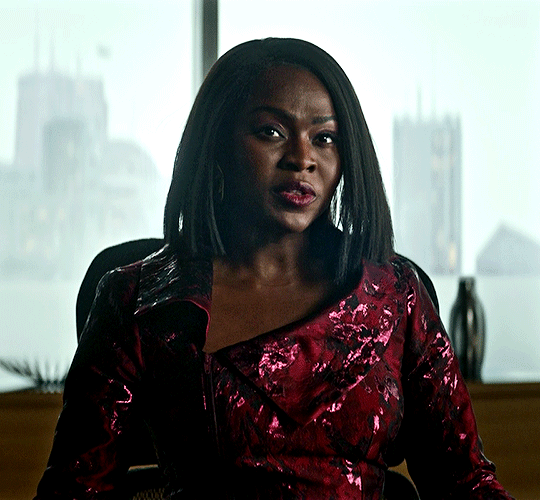
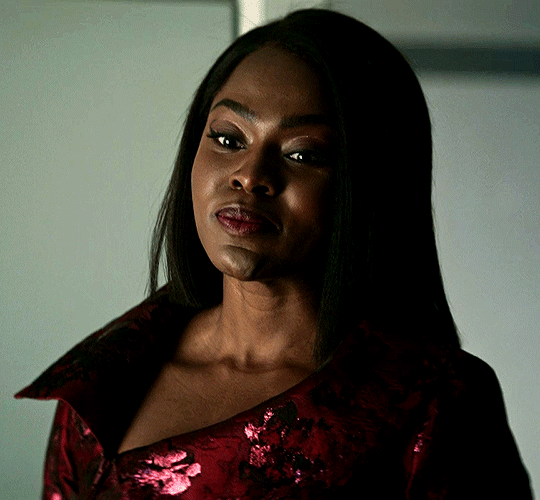



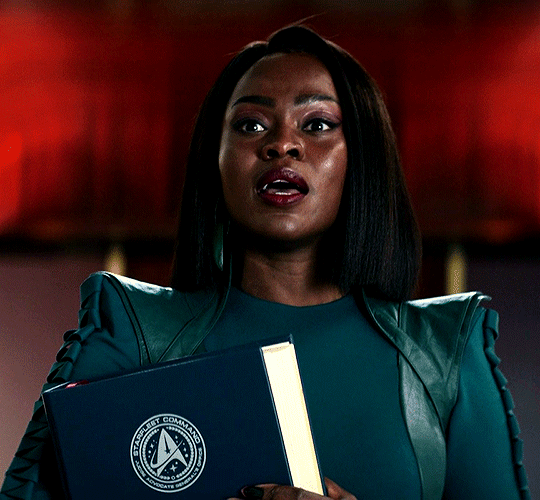
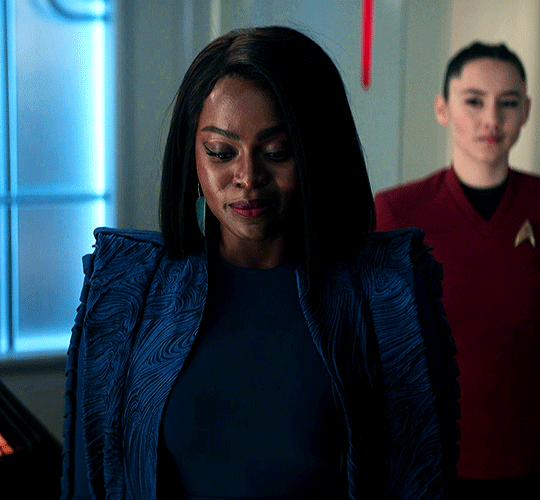
A law does not make something just. I’m not saying the Federation means to do harm. Their experience with genetic modification... The Eugenics Wars was horrific. The pain that Earth felt, unimaginable. The Federation built a utopia in its wake, and in an effort to protect that utopia, they became blinded by a centuries-old fear, so much so that they have, perhaps unknowingly, become persecutors.
Yetide Badaki as Neera Ketoul STAR TREK: STRANGE NEW WORLDS “Ad Astra per Aspera” (2.02)
#trekedit#star trek#star trek strange new worlds#yetide badaki#usertoph#tuserpolly#usermichi#userk8#snw#gifs#mine#QUEEN <3
562 notes
·
View notes
Text
I'm watching the State of the Union and I'm reminded why no matter what, we won't have justice as long as we have representative democracy. Biden just claimed "I will not rest until we rescue all the hostages held by Gaza" and then realized it was bad press to not be against the Palestinian genocide and then immediately started stating he wanted a ceasefire and wanted innocent Palestinians to be protected, and THEN stated he sided with Israel.
Typical politician... Just say the words people want to hear about the issues they care about just to get votes so you can stay in power. Politicians don't, won't, and never will care about what we want except for how it relates to them.
As long as we let them have power over us, we will never have power over what atrocities they will support and enable, both on our own land, and all over the world. The US government won't stop destroying the environment and keeping us in poverty if we ask them politely to stop. They won't dismantle a police system built on favoring police officers and the incarceration and execution of innocent people, they won't give stolen land back, they won't completely outlaw slavery or dismantle the numerous eugenics laws towards disabled people that still exist. They won't be against genocide, even when it's actively happening.
And even if they do, it'll be a means to an end. It'll be a distraction. They'll just be dangling it in front of our faces saying "Look! We did what you wanted! We're on your side! We totally care about social justice!"
Although I dont want to, I'm voting for Biden just so Trump doesn't become president. But mark my words, whats stopping the next democratic president from doing stuff like Joe Biden did? Lying to us about caring about justice, just saying what we want to hear? And even if we vote, say, a socialist president, whats stopping them from doing the same thing?
I dont know what we do about this, but when the time comes, we need to organize on a large scale and do SOMETHING. I dont know what or how, but we need to change something, and not be okay with system where people in power make the big choices for us, and we just hope they do what we want with not a care in the world about injustice.
#free gaza#free palestine#activism#social justice#abortion#ableism#gaza#palestine#israel#news on gaza#joe biden
91 notes
·
View notes
Text
I'm sorry but pls be so real right now. there are way too many people surprised that a girl with Down Syndrome was put in that arena. Literally look at our laws RIGHT NOW about what kinds of support or protection disabled people have in the country. There are places legally allowed to use over powered cow prods on disabled people
disabled people weren't allowed out in public until RECENTLY. Disabled people can't get married without potentially losing the little benefits they get. We have to fight for Bare Minimum accessibility at all times. The Holocaust was jump started as a solution of removing disabled people who "drained resources". Disabled people are sterilized against their will or without being told. Disability pay literally is not enough to live on and it's engineered that way
this country was Built on eugenics and the blood and bodies of disabled people*
it is absolutely, one hundred percent, not surprising in the Least. President Snow isn't some special kind of monster to put a disabled girl in that arena. Most politicians today would do it within a blink of an eye sorry lol
#the hunger games#abosas#a ballad of songbirds and snakes#wovey#wovey tbosas#*obvs also this includes poc and other marginalized communities!!!!!
143 notes
·
View notes
Text
This is absolutely hilarious.
I was just informed that someone is accusing me of calling for the extermination of black babies in the womb in order to prevent the Great Replacement Theory from happening.
Obviously the accusation is entirely fabricated and the person making it is making crap up to try to cause infighting among pro-lifers on tumblr. But anyone who believes it obviously…
1. Has not read any of my posts ever about abortion
2. Does not actually know what the Great Replacement Theory is (or thinks I don’t, at least)
So anyway, in case there’s any confusion:
- No one should be aborted (including black babies)
- Eugenics is bad
- Here’s the Maafa 21 documentary (which I have posted numerous times on this blog) that explains how eugenicist groups conspired to use birth control, forced sterilization, and abortion to “control” the black population (and again, to be perfectly clear, I am saying this is a bad thing)
youtube
Oh did I mention already that eugenics is bad and I want all preborn babies given equal protection under the law?
95 notes
·
View notes
Text
There are ways to do retcons properly
Nothing incenses an audience quite like a retcon, more so if it’s one done deliberately and not by the writer simply forgetting or not knowing that they’re retconning in the first place. Beyond just being the man behind the curtain going “uhhh you didn’t see that last bit, just trust me, this is the new canon” reading as lazy and breaking the immersion, it’s seen as at best, uncreative and at worst, actively dismissive and disrespectful of the canon that came before, especially if this isn’t the original writer.
There’s hundreds of examples of terrible retcons, most recently in the litany of reboots and live action remakes.
But if you’re a solo author and you realize you’ve made a mistake that you must retcon in order to tell the grander story effectively, here’s some suggestions for how to handle that.
—
Have a character say they made a mistake, and make this mistake have lasting consequences
Mistakes are human. Characters simply “making a mistake” in fiction tends to go over poorly because it’s not a satisfying or meaningful direction for the story to take. Unless this is heavily foreshadowed or the character is deliberately set up for failure and the audience knows this, or the character chronically makes these kinds of mistakes, it feels like the hand of the author giving a diabolus ex machina—outside of the control or autonomy of any of the characters, suddenly they are wrong because the author says so.
So if you haven’t done the prep work for this big mistake, because you didn’t realize it would be one until it’s too late to change it, you can have this mistake fundamentally change the character. That way the retcon becomes more than the author patching holes, it’s now part of this character’s growth.
Have the characters be misinformed by a bad actor or propaganda
Like above, having a character out of nowhere go “eh, I lied” to patch your plot hole is weak, if it comes out of nowhere for them and never shows up as something they would do again.
However, if your cast lives in a world where multiple sides are prone to making shit up about each other (as all sides are in every conflict), you can take a piece of wrong information and bake it into the plot as part of a deeper conspiracy. Or simply a loss of trust in the original source of the information, or a change of worldview about how they won’t be duped again.
—
Whatever the case, making a retcon work might demand changing your original plan to incorporate how these characters approach the new laws and lore of their world now thrust upon them. They might be frustrated, wary, confused, upset, distraught, or devastated depending on the severity of the retcon. It should mean something fundamentally to them that what they previously thought is now wrong.
You don’t have to turn it into this big thing if it’s a minor retcon, like, somebody’s eyes now have to change colors. Leaning too far into a long explanation wraps back around to being convoluted. Sometimes it really is just better to say nothing and not call attention to it (but if it is that minor, why are you retconning in the first place?).
If I’m writing a contemporary romance series and between books Mr. Tall Dark and Handsome had blue eyes but now I really want them to be brown because I just like brown eyes…that ship has sailed? Write another book for your brown-eyed beau.
If I’m writing a fantasy story and Mr. Tall Dark and Handsome absolutely must have brown eyes because eye color is crucial to bloodlines and majorly important to his character and arc, and I accidentally gave him blue before fully realizing my lore, I now have to figure out, within the reality of the world I built, how to fix this error.
Maybe that means he has to be adopted, or some nefarious magician changed his eye color as an infant to protect him in some grand conspiracy, or the actual lore behind magical eyes is one big lie to support fantasy eugenics. How much you focus on changing the retcon should be proportional to how important this retconned detail is to the story, and how realistic this new explanation would be.
If I say magicians dyed this boy’s eyes… I gotta already have established that there exists magicians who could potentially do this.
Hand-waving critical things away, or giving a BS excuse so we can quickly move on, or insulting the audience for believing this is how the world works as you’ve told it to them and trying to spin yourself as oh so clever isn’t going to end well for you.
But also… if you act with some humility and admit you just forgot, audiences are likely to be more forgiving than if you do contrive some long-winded explanation and act like it was your plan all along.
There’s a balance, and it’s highly situational.
Hope this helps?
#writing#writeblr#writing a book#writing advice#writing resources#writing tools#writing tips#retcons#plot holes
15 notes
·
View notes
Text
An Analysis of Haruka’s MVs: Distance and Disability
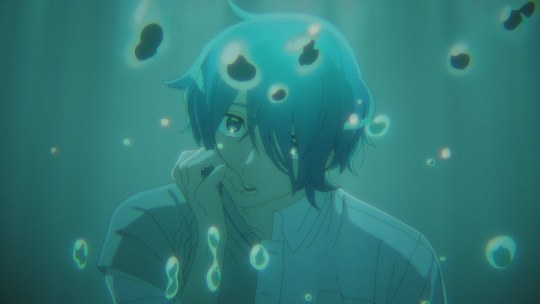
Hello! I’ve recently fallen down the rabbit hole that is Milgram and I have been itching to make some completely normal and sane analysis posts. My silly alternate title for this was gonna be “Things About Haruka’s MVs That Just Make Sense: A Hyperfixation-fuelled Analysis”, because honestly my autistic brain has been having a field day over here.
I am in awe with just about every single music video in this project; the animation is incredible and each one packs so much carefully laid out information. But I have been rotating Haruka’s in my head constantly since I first watched them, and I have a lot of Thoughts. Not about whether he’s guilty or innocent/forgiven or unforgiven. Not about whether or not I can justify his murders. Just some straight up imagery and symbolism analysis, through the lens of disability.
Haruka’s disability has not been specified, but I am confident we can at least say he is neurodivergent. I feel like the cultural differences in names for several things e.g. ‘learning disability’ vs ‘learning difficulty’ will just invite unnecessary drama, and is a little pedantic. What does matter here is that Haruka's experience as a disabled person is heavily intertwined within his story and his motives.
So, without further ado... let’s get into this!
Trigger warnings/TW: I will be discussing ableism, eugenics and harm towards disabled people. Everything else will be related to the music videos ‘Weakness’ and ‘All Knowing and All Agony’, so any triggering content within them may also be mentioned. Read at your own discretion and stay safe!
Disability: some brief (important) historical context
It is only within the last few decades that those who are disabled have been ‘seen’ for the first time. A modern society is (ideally) expected to be built to include and accommodate for disability, and to acknowledge disabled people’s existence. But for many countries (even the ones making steps outlined above) this is still not the case. For a very, very long time, globally, that has not been the case.
For most disabled people, society makes it very clear that they are a burden to it and are better off not existing.
I’m going to make this section as succinct as possible because...it’s heavy stuff. But it’s important, and I want you all to get the gist of what I’m saying. The weight of it.
Let’s highlight a piece of history regarding IQ and eugenics, surrounding the publication and subsequent worldwide reception of ‘The Kallikak Family: A Study in the Heredity of Feeble-mindedness’ by Henry Herbert Goddard in 1913:
“In 1927, it was used as evidence in the case of Buck v. Bell, which culminated in a Supreme Court ruling that the involuntary sterilization of ‘mentally defective’ persons was not unconstitutional in the United States. By 1938, thirty-three US states had passed laws allowing for the forced sterilization of women with learning disabilities and twenty-nine had made sterilization compulsory for people who were thought to have genetic conditions. Many European countries followed suit: Denmark in 1929, then Norway in 1934, and after that Sweden, Finland, Estonia, Iceland, Czechoslovakia, Yugoslavia, Latvia, Hungary and Turkey.”
— Limburg, J. (2021) Letters To My Weird Sisters: On Autism and Feminism, p. 126
This history of a ‘sterilization law’ includes Japan, who between 1948 and 1996 enacted the Eugenics Protection Law which “authorised the sterilization of people with intellectual disabilities, mental illnesses or hereditary disorders.” According to the government, about 25,000 were sterilized.
SO. It’s important to bring this up. To establish how much disabled people are not wanted, just from their governments. Let alone society. To this day, disabled people are hidden away from the public by families that are ashamed of their existence.
Japanese culture values collectivism, and maintaining the harmony of a group...to the extent of excluding those that don’t fit into the mould. That are different.
The question is: where do they go? The ones that are publicly rejected?
Haruka and The Curious Case of Distant Waters
Okay that’s enough of the heavy real-world stuff! Time to delve into some...*checks notes*...heavy fictional stuff. Fun!
Haruka’s MVs prominently display themes of distance and separation through the motif of water, specifically being submerged underwater.
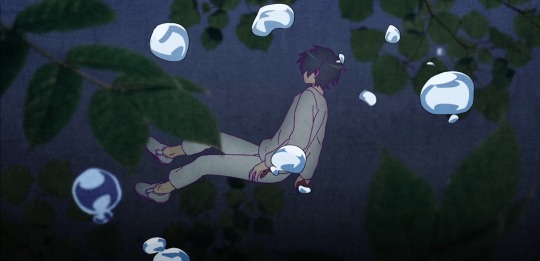
The name Haruka reinforces this concept as the specific kanji used (遥) translates to ‘distant’, ‘remote’ or ‘far away’. As there are many, many kanji choices for the name (including but not limited to: ocean/sea, eternity/permeance, clear/distinct/obvious, and spring/growth/cherry blossom) it feels like a particularly cruel and intentional choice to go with that one.
Through the exploration of this motif, we can see the extent in which Otherness/the state of being ‘Other’ drives Haruka to great lengths to close the distance and escape it.
What I noticed throughout both MVs (particularly AK&AA but note the beginning scene of Weakness), is that whenever Haruka looks at himself in a reflective surface (e.g. the vanity mirror, the fish tank), water either begins to rise and overwhelms him, or is already there and he appears submerged:
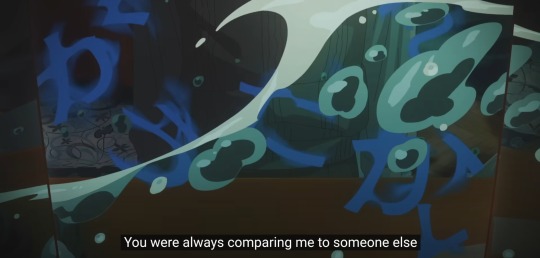
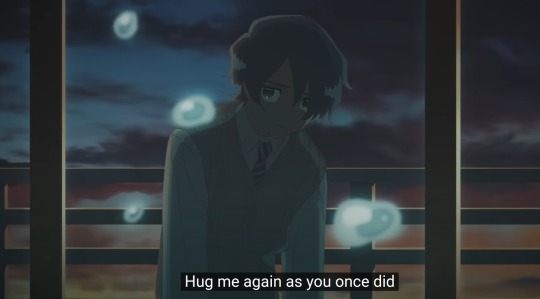
I think this is the “All-Knowing” part of AK&AA. He knows he’s different, and he knows there’s a huge ocean between him and his peers, his family, everyone. A disconnect when trying to listen and understand, but also when trying to be understood by others and listened to himself.
You know when you submerge your head in water, and your hearing gets all muffled and incomprehensible? And have you ever tried speaking underwater? You can’t, because if you open your mouth you’ll drown. It’ll just come out as bubbles rising to the surface.
I also think the bubbles symbolise rising tension, between what he wants and what he currently has. Bubbles are everywhere in these MVs, even in places where they shouldn’t logically be? Such as this scene, following the line “don’t wipe me out, don’t wipe me out”:

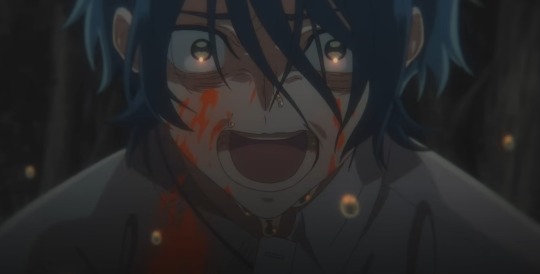
Immediately pans up to Haruka gasping for breath, droplets of water rising from...somewhere. For about a split second, and they’re gone.
This boy is really going through it. I’m getting an ‘emerging from the ocean before I drown’ vibe from this one folks. When the line that follows this scene is “I can’t stop, I can’t stop”, what I’m REALLY hearing is “I can’t stop (killing) or I’ll drown”. This is his lifeboat, pulling him out from the depths of being neglected and hidden away, into the spotlight.
Some interesting images from Weakness in relation to that (of spotlights):


Anyways, onto the next point:
Blue to Orange: Water to...Nectar?
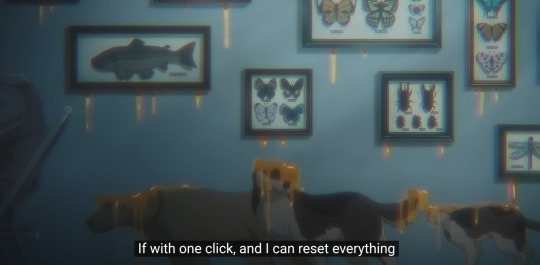
So, the orange liquid. It’s clearly representing blood, but I don’t think this is just a “danganronpa pink blood” situation of censoring/getting this video onto youtube without restrictions.
I think it’s most likely honey, specifically nectar.
The etymology of the word nectar shows its compounds translate to “death” and “overcoming”. Nectar is also called the drink of the gods, so it would make sense for it to be a ‘death-defeating’, immortalizing liquid.
For Haruka’s victims to contain nectar is very interesting. It reinforces that necessity to kill, to take the life of another, to sustain himself. To overcome the ‘living death’ he is experiencing by being hidden away from society.
This is his means of escape from drowning.
However, as we all know, things don’t turn out great for him. By the end of AK&AA Haruka is rejected once again by his mother, after which the door is shut (the light with it is gone too) and we’re met with this imagery:
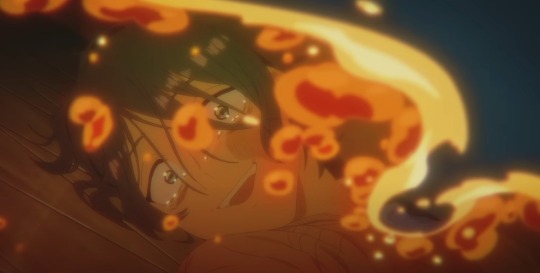

The nectar floods the room, engulfing him much like the water from earlier.
There are many things we could take from this. One being that the nectar-gathering/killing-spree has clouded his vision; it’s so sweet, so sickly sweet and he’s addicted to the taste of attention, even if it’s very bad attention.
Who else has honey imagery in their MV again?
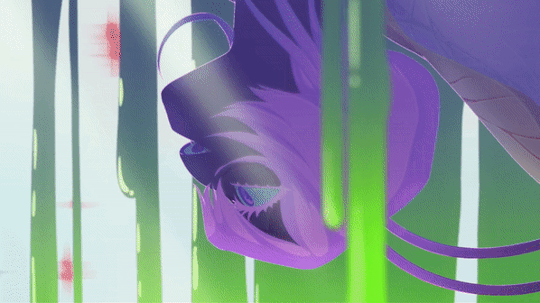
Oh, right.
Anyway, the nectar/honey situation could also be representing submerging into an even further level of distance. All that murder is gonna push people away, despite his motive being to close the gap between him and normal people. The 'ocean’ has lost clarity and become a maddening, delusional substance. After all, there is a type of honey literally called ‘mad honey’ known for its medicinal and hallucinogenic properties.
That’s enough about honey, though. Let’s move onto less unfortunate... oh, sorry, what was that? *checks notes*...Ah, yes. I meant to say, let’s move onto even more unfortunate symbolism:
The Necklace

So, this necklace. Haruka steals it from his mother’s belongings, and is his only material, physical connection to her. It is taken on the declaration of “making (her) love me again” and getting her attention once more, now he is no longer a child but a teenager closer to adulthood (at least, that’s what I consider the ‘shirt with a vest sweater and tie’ to represent. child him = the blue polo, teenager him = this one, adult him = an amalgamation of his teenager clothes).
I wasn’t sure if this was an opal or pearl/mother of pearl, but I’m leaning towards opal from the other depiction of it in Weakness:
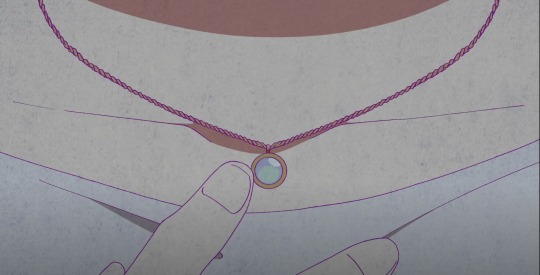
Opals are fun because they can symbolise both good luck and bad luck, usually to do with whether it’s your birthstone. There’s something to be said of Haruka’s belief in his ‘misfortune’ and the superstition surrounding these gemstones.
But they are even more interesting for the powers they supposedly have; in medieval times the opal was considered the ‘patron of thieves’ for their ability to grant the wearer invisibility.
There is a deliciously sad irony to Haruka’s theft with that titbit of information.
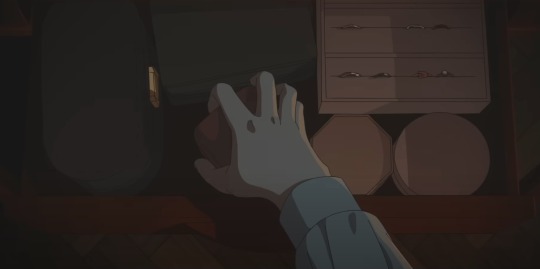
Now, if this isn’t an opal, and it’s a pearl/mother of pearl there’s still some fun interpretation to be had! A little less sad, even. Pearls invoke strong imagery of the sea, of purity, and of a connection to the maternal. If this is the last thing he has relating to his mother, I can see this necklace representing a lifeline when he’s deep in the ocean. A reminder of why he’s doing all of this killing, and who it’s for.
His mother’s attention (or the idea of having a mother at all, any mother) is his driving force in life.
Speaking of that...
So We Really Need To Talk About That Fish Tank: AKA, Why Haruka’s Mom Wins ‘The Worst Parent of The Year’ Award
This fucking fish tank.
Okay, I’m gonna start by saying: I don’t think this is reading too far into things. When it takes an animation team months, sometimes years to create a 3-5 minute music video, and one as detailed as this...you don’t just wing it. There are storyboards, there are key frames and there are choices made down to the smallest of details.
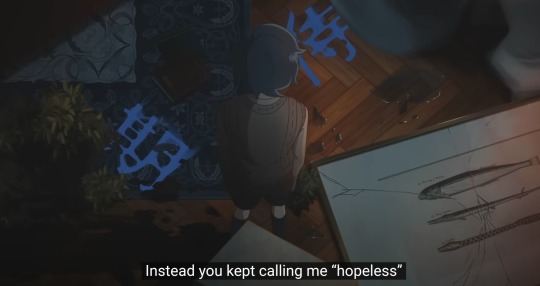
From the sheer volume of animal/insect/fish décor that resides in the Sakurai household, you bet I’m gonna pay attention to what type of fish are in that fish tank.

For one thing, they live in saltwater. This is a marine tank, aka the harder choice of aquarium to have. I mean, way, WAY harder. For the experienced only.
These fish right here? One is a clownfish, and the other is a yellow boxfish.
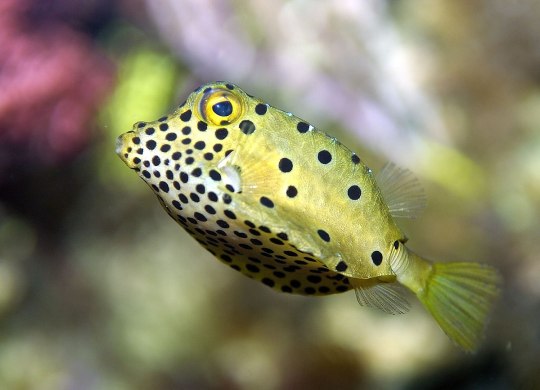
Boxfish are a nightmare to keep alive. This article goes into more detail than I will, but all you need to know is: if there was ever a fish out of all the fish you could possibly want in your tank, this is the one to avoid like the plague.
They release deadly toxins when stressed, as a survival instinct. Boom. All your fish are dead. They need to eat a shit ton of food, but are notoriously clumsy swimmers and slow eaters. Boom. Starving, stressed out boxfish. Boxfish either dies from starvation or dies from stress and toxins.
For Haruka’s mom to have not just one of these fuckers, but a tank consisting ONLY OF MULTIPLE BOXFISH AND CLOWNFISH...

This is a high-maintenance tank. And it shows how much time and effort, how much care she puts into the things she loves.
How neglectful she is as a parent of a disabled child in contrast.
There’s something about the last scene between Haruka and his mother that reinforces this for me:
Haruka’s relationship with animals and himself: AKA, “why don’t I just become the damn fish tank?”
Let me backpedal a little bit. This subheading will make sense in a minute.
So, like I said earlier we have a lot of décor in this house relating to insects and fish. We also have a lot of pets. Both living and dead, taxidermized creatures in one household, proudly on display.

I think this may have created some confusion for Haruka regarding the value of animals being alive or dead, as in his perspective his mother values both equally. The fish in a tank may be full of alive creatures, but they’re still on display as if it’s artwork. Isn’t breaking the glass of a framed picture of a fish equal to breaking the glass of a tank with a ‘picture of living fish’?
(This isn’t to say Haruka is clueless to the impact of his actions, nor to justify any harm to animals. I just find the train of thought to be intriguing.)
So when considering these ‘objects’ are proud trophies of his work:
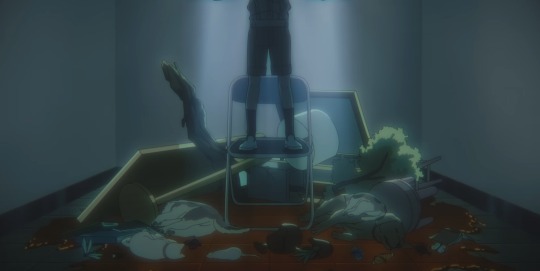
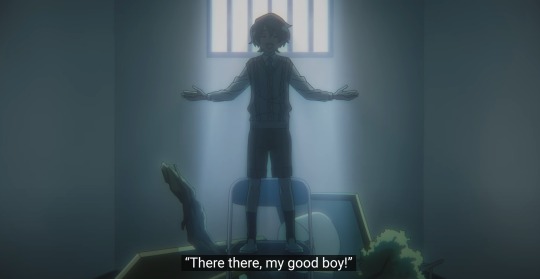
This is a carefully arranged display, which by the way, doesn’t contain a single fish. In fact the only piece of that moment visible here is the...large piece of driftwood? Okay. Keep that in mind.
We proceed into Haruka’s mother opening the door and seeing her son, for the first time in any of the MVs. Note the way they composed this shot:

I’m obsessed with this scene. The blue eye framing Haruka, with a literal fishbowl effect on him...
He is the goddamn fish in the aquarium now. His mother’s full attention is on him and him alone, with only the dead animals, the books, the lamp and the driftwood as window dressing to this wonderful display.
Doesn’t it just scream “Look at me! Look at what I did, mom!” to you?
That blue spotlight is on him once more. He is not just drifting deeper into an endless ocean, but contained in a vessel to be stared at.
One Last Observation
I didn’t know where to fit this in but I think the end feels appropriate.
His clothing here:
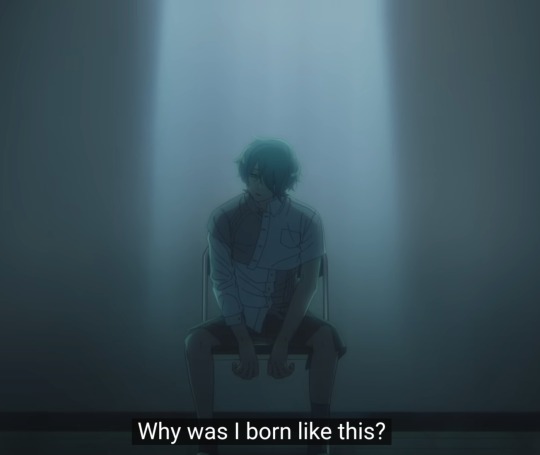
Is a frankenstein-esque mash up of clothes from his younger years. He wears this throughout AK&AA, and as I mentioned before it signifies him as an adult. However, I should clarify what I mean here as Haruka says “he thinks he’s 17″ and “doesn’t care about his age”. So... not an adult, but on the cusp of adulthood.
But I think he actually does care about his age, and quite a lot too.
This outfit feels symbolic of refusing to let go of the past, and of himself as a child. He’s literally grown out of his clothing, but he still clings onto it. He’s attached to the past because it not only contains his happiest moments, but the change from being loved to becoming neglected.
As a disabled person, you’re often treated with a lot more forgiveness when you’re younger. That is to say, some people don’t realise that children with disabilities grow up into adults with disabilities. There is a point where even support from medical and social services drops off like a cliff edge once you turn 18.
The ill-fitting clothing in this context becomes more than a reflection on Haruka’s feelings, and extends to reflecting society’s feelings on disabled adults ‘refusing to grow up’.
I don’t blame Haruka for holding onto his childhood like this. He’ll be even less publicly visible and seen once he is no longer a pitiful child, but a ‘weird’ adult in ill-fitting, children’s clothes.
#milgram#haruka sakurai#analysis#weakness#all-knowing and all-agony#symbolism#disability#*drops this onto the fandom like a ton of bricks* hi i'm new here pleasure to meet u#oh man I finally finished it... this is a very (and I mean a VERY) long post asdfghjkl#I'm pretty happy with how it turned out though! I got most of the things I wanted to say and point out down#believe it or not there was actually MORE I could've said but I think tumblr may have crashed on me if I did that lmao#particularly to do with Weakness as I focused more on AK&AA here. but anyways#I love how morally grey everyone is in this series! It makes for some really fun analysis!#it's so so nice seeing a disabled character in such a position too and not just 'is a cinnamon roll' or 'the devil reincarnate' yknow#I debated leaving in the real-world history stuff but I think it sets the tone of my analysis pretty well and shows the importance of--#--haruka's disability not as a justification of his actions but as a vital backdrop to his environment and struggles
259 notes
·
View notes
Text
Five Tangled AUs I'll Never Write Because I Don't Have The Time
1. Eugene gets adopted by Quirin instead of going to the orphanage.
He still becomes Flynn Rider and rescues Rapunzel from the tower, but his turn to crime is due to a falling out between him and his dad after his and Varian's mom disappears under mysterious circumstances.
Quirin is keeping secrets, and thier relationship is strained, but after meeting Rapunzel, Eugene is trying to mend that relationship with him... Only for the amber incident to cut that short.
Obviously the biggest change here is that Eugene and Varian are brothers, so Varian isn't left alone after the snow storm. Rather, Eugene is trying to protect Varian from King Frederic while also trying to stay in his future father-in-law's good graces... All while dealing with his own grief.
This drastically changes the conflict and outcome of season one. Forcing Rapunzel to confront her father directly and own up to his misdeeds, and brings Varian along on the season two road trip.
Also Eugene has even less reason to accept Edmund because Quirin is the man who raised him and is his 'real dad' for all intents and purposes.
Also, thier mom, Ulla, being trapped by Zan Tiri and finally escaping would be a major plot point in season three.
2. Digimon AU
Rapunzel, Eugene, Cassandra, Varian, Lance, Styalan, and Caine are all college students who get sucked into the digital world.
They each get their own digimon and must face off against the seven digimon demon lords in order to return home, and in doing so confront their own worse vices.
Rapunzel's digimon is Coronamon. She is The Leader of the group and her element is Fire/Light/Sun. Her nemesis is Belphemon, and her main vice is Sloth. Because she keeps avoiding her problems by chasing after frivolous pursuits. Such as standing up to her abusive mother Gothel, or dealing with her responsibilities as the leader of her team.
Eugene’s partner is Kudamon. He’s The Mediator of the group. The voice of reason and common sense. His elemental is Wind. His nemesis is Lucemon, and his main vice is Pride, for his uses vanity to compensate for his low self esteem born from growing up in the foster system.
Cassandra’s digimon is Lunamon, and her rival is Leviamon. Her fatal flaw is Envy, for she’s jealous of Rapunzel. She’s The Second in Command; because she offers a counter balance to Rapunzel’s way of doing things, but they butt heads often. Her element is Darkness/Moon.
Varian is The Brains of the outfit. His digimon is Labramon, who can change to either a vaccine or virus upon evolution. However his main thematic element is Electricity. His nemesis is Daemon and his vice is Wrath. As the youngest in the group, he often feels unheard and will lash out in anger.
Lance is The Heart of the team, as he’s forever the optimist. His digimon is Otamamon and his element is Water. His rival is Beelzemon, and his fatal flaw is Gluttony, for he never had enough growing up in the foster care system, therefore he shows no restraint when given opportunities, even if it means hurting someone else.
Caine is The Muscle of the group. Her digimon, Goblimon, is a heavy hitter when he digivoles, and she’s the most likely to throw a punch against a monster on her own. Her enemy is Barbamon, and her vice is Greed. She’s criminal on the run for theft, but it’s a life she feels she was forced into. Her element is Metal/Ground.
Stalyan is The Chick, for lack of a better trope term. She’s daddy’s spoiled little rich girl who is in for a rude wake up call when she gets to the Digital World. Her digimon is Floramon and her element is Grass. Her rival is Laylamon and her fatal flaw is Lust. She’s in love with Eugene, but he doesn’t return her feelings. Her obsession with him, is tied to her own insecurities and desires for being accepted.
3. Prince Varian
Varian is Rapunzel’s little brother. He’s actually Arianna and Quirin’s son, but Frederic raised him as his own. Both are ignorant of Varian’s true parentage, with Varian just believing Quirin is his bodyguard/mentor.
Yet with the return of his long lost sister Varian feels even more out of place with in the Castle and keeps sneaking off to Old Corona to visit Quirin, who is now a retired knight, and to work on his experiments in secret.
Only the truth comes out after a horrible lab accident that traps Quirin in amber, and now Varian doesn’t know where he belongs.
4. Eugene is raised by Hector
Horace knows who he is and his duty to keep the moonstone safe. He has rarely traveled beyond the great tree. But he begins to question his entire place in the world when a group of travelers come in search of his family's treasure, with one of them claiming to be the living embodiment of the fabled Sundrop.
Since Eugene/Horace never left the Great Tree, he never became Flynn Rider, never stole the crown, and never met Rapunzel in the tower.
This means Rapunzel never leaves on her 18th birthday to see the lights, but her tower is destroyed by the black rocks six months later. Leaving her and Mother Gothel without a home.
While in search of a new place to live they meet, Varian, who is trying to figure out the mystery of the rocks, Cassandra, who is searching for the lost princess to prove her worth to her dad, and Lance, a thief who offers to be their guide in order to hide from the Stabbingtons who he owes money too.
The five of them go on a quest to find the moonstone when Varian shows them the piece of his father's scroll (who is not trapped in amber this time) much to the discouragement/disapproval of Mother Gothel.
Gothel tries to dismiss the legends of the moonstone while keeping her and Rapunzel's identities secret. (Everyone figures out she's the Sundrop/connected to the rocks right away, but not that's she's the lost princess) But as she can't be too far away from her precious flower for too long she gets dragged on the quest anyways.
Cue Gothel reluctantly becoming everyone's mama as she tries to keep them alive and convince Raps to give up this silly quest and find a new home, while also not letting it slip that she's really Cass's birth mother, nor the thief of the long lost princess, nor an ancient sorceress who betrayed a powerful demon in order to have eternal youth and said demon could come back to kill them all if released by the Sundrop touching the Moonstone.
Basically what I'm getting at is we have a scenario where a manipulative asshole who is desperately just trying to survive while not being caught in her web of lies, is slowly coming to care for a bunch of snot-nosed, bratty, insecure teenagers, and she hates it!
This also means that by the time the gang reaches the Great Tree, Rapunzel's and Eugene's roles are reversed. She's the experienced adventurer using him, though unintentionally on her part, to get what she wants, while unexpectedly falling in love, and he's the sheltered shut in who discovers that there's more to the world.
And just to complicate matters, King Frederic, Quirin, and Adria, team up to invade The Dark Kingdom in order to destroy the moonstone with Adria's sword. Quirin betraying his brother Edmund because he thinks Varian is dead from the rocks having destroyed their village/castle in the night.
5. Cassandra is the Dark Princess
I mean, I think this should have been cannon anyways, but Cassandra and Eugene are long lost siblings. Both are heirs to the Dark Kingdom and it's their mom who is left alive to guard the Moonstone.
Said Mom thought they were both lost when the kingdom fell, not knowing that their nurse saved them on the night Edmund went mad.
The Queen convinces Cassandra that protecting the moonstone from the Sundrop is her duty, believing that both coming together will destroy the world. Not realizing that Cass would actually grab it away from Raps in their fight over it and become possessed by Zahn Tiri in the process.
#tangled#tangled the series#rapunzel's tangled adventure#rapunzel#varian#eugene fitzherbert#cassandra#lance strongbow#caine#stalyan
49 notes
·
View notes
Text
Whitewash is extremely moral. Suppose there were a decree requiring all rooms in Paris to be given a coat of whitewash. I maintain that that would be a police task of real stature and a manifestation of high morality, the sign of a great people. -- Le Corbusier
A shocking call for compulsory whitening is made at the end of a key modernist manifesto. The pronouncement is associated with the signature whiteness of modern architecture -- an aesthetic regime that was presented as a complete revolution of the built environment in the 1920s and became the unconscious default setting of everyday life. Just look at the predominantly white background of most of the kitchens, offices, living rooms, bedrooms and bathrooms around the world [...]. Le Corbusier didn’t simply call for whitewash to be imposed by the police in the name of health. It was meant to act as a form of policing in its own right, a technology of surveillance that would put in motion an ever-expanding culture of self-policing. Whitewash exposes every dimension of life in front of it to judgement. It acts like “a court of assize in permanent session” that will “give a power of judgement to the individual,” and thereby “make each one of us a prudent judge.” [...] A “Law of Ripolin” -- the brand name of the hard impermeable and washable enamel “sanitary paint” invented at the end of the nineteenth century [...] is needed to ensure that all interiors are painted white to target any form of dirt or darkness:
Imagine the results of the Law of Ripolin. Every citizen is required to replace his hangings, his damasks, his wall-papers, his stencils, with a plain coat of white ripolin. His home is made clean. There are no more dirty, dark corners. Everything is shown as it is. Then comes inner cleanness [...]. When you are surrounded with shadows and dark corners you are at home only as far as the hazy edges of the darkness your eyes cannot penetrate. You are not master in your own house. Once you have put ripolin on your walls you will be master of yourself. [...]
---
Whiteness manufactures health, morality, and intelligence. [...] The office of a modern factory that is “clear and rectilinear and painted with white ripolin” is a place of “healthy activity” and “industrious optimism.” [...] Le Corbusier’s routinely authoritarian and often explicitly eugenic and fascist impulses, associations, and actions make him an easy target. But there are endless, quieter, ultimately more controlling and insidious celebrations of whiteness in other hands. Le Corbusier is but a tip of the vast iceberg of whiteness. [...]
The very idea of an interior is the effect of this everyday violence. Architecture is never simply complicit with authority. Authority without architecture might not even be thinkable. [...]
There is no apolitical concept of health; no natural body or brain waiting to be cared for or abandoned by medicine and architecture that is not already an effect of those biopolitical regimes.
It is through the question of sickness that architecture reshapes the human. The idea of a healthy architecture is always about the health of a small group relative to multiple others [...]. Whiteness is coded as a fragility requiring protection through continual acts of preemptive violence. Whiteness is not a thing but a defense and deployment of power over others. [...]
---
Whiteness in Le Corbusier’s The Decorative Art of Today, for example, is simultaneously the most modern thing to do, the very symptom of modernity, and the most ancient of gestures. [...] Le Corbusier’s argument was first published in a late 1923 issue of L’Esprit Nouveau [...]. It was, after all, the extended ��Voyage d’Orient” of 1911 (including the Balkans and Greece, but especially Turkey) where Charles-Édouard Jeanneret, the young architect from a small mountain town in Switzerland who would a decade later rename himself “Le Corbusier,” became “besotted with white” and convinced that the future of architecture was white. Whiteness is discovered in the lands of the non-white; of those seen to be closer to deeper human history and therefore to be admired and learned from. In fact, the very point of going to the East was to encounter its “great white walls” as an antidote to the self-absorbed decadence of architecture in the North, as Jeanneret explained [...]. Jeanneret expresses nostalgia for the more intact and mesmerizing whiteness of the great mosques and vernacular houses of Constantinople (Istanbul) [...] [and] “Algiers-the-white.” [...] This pervasive sense of contamination provoked the call for a second, more explicit law to impose whiteness not only onto industrial culture, but also onto its victims: the people of color and places seen as newly “unhealthy” -- requiring, as it were, a dose of “their” own medicine. [...]
---
The “white” architecture of the 1920s drew on countless experiments in whitening buildings in the name of health. This included, precisely, the use of Ripolin that had already become standard in clinics, hospital wards, and sanatoria rooms at the turn of the century.
In 1899, for example, the Touring-Club de France, inspired by one of its [...] cyclist members who was a doctor, started a campaign for an easily disinfected “hygienic room” in hotels that would be Ripolin-lined [...]. Hotel rooms were treated as hotspots for contagion [...]. Given the largely upper-middle-class membership of the club, this anxiety about disease was also class anxiety, fear of the unclean other. The tourist was to be mobile yet isolated by a prophylactic whiteness that would itself travel in advance.
The Touring-Club exhibited such a prototype “white room” with toilette and toilet spaces designed by Gustave Rives at the 1900 Exposition Universelle in Paris -- strategically placed just inside the entrance of the Palais de l’hygiène [...]. The Touring-Club installed a series of such model chambres hygiéniques in automobile shows, congresses on tuberculosis, and international fairs. It was successful in persuading thousands of hotels to install such spaces [...].
Ripolin was used “everywhere,” for example, on the walls of the “hygienic housing��� project for workers in Paris by Henri Sauvage and Charles Sarazin in 1903–1904. [...] The project was originally intended to feature a radical all-glass street façade with every window surrounded by webs of floor-to-ceiling hexagonal glass blocks [...] which would have been the most polemical housing structure possible, the most therapeutic role of glass, more extreme even than any sanatorium. The design was produced in immediate response to the new public health law of 1902 and the associated new building regulations. [...]
---
It is always about control of the threatening other of epidemic disease and control of the laboring poor, itself coded as dark, migrant, and contagious, a disease in its own right. And throughout this discourse of control, there is a seemingly “modern” disdain for disease-incubating ornament in favor of smooth white surfaces. [...] What is remarkable in the end is this trans-historical resilience of whiteness [...]. It orchestrates life and death.
---
All text above by: Mark Wigley. “Chronic Whiteness.” e-flux (Sick Architecture series). November 2020. [Bold emphasis and some paragraph breaks/contractions added by me.]
#ecology#abolition#health#imperial#colonial#landscape#modernity#temporal#indigenous#multispecies#tidalectics#archipelagic thinking#pathologization#haunted#halloween i guess idk#victorian and edwardian popular culture#racialized architecture#moral whitewash
237 notes
·
View notes
Text
by Eugene Kontorovich
Hamas’ grisly terror raid on Oct. 7 has proved to be the single most stunningly successful act in gaining support for the Palestinian cause—not among Israeli or American voters, of course, but among top Democratic policymakers, and their counterparts across the Western world. One might think that a campaign of unrepentant killing, torture, rape, and hostage-taking would be disqualifying for a national independence movement. But in Washington, Hamas’ ongoing crimes have resulted in much of the weight of the U.S. government being brought to bear on advancing the cause of Palestinian statehood, and its correlate, the punishment and demonization of the Jewish state.
Months of U.S. backing for the Palestinian national cause have produced glorious results for Palestinian diplomacy. Whereas less than two years ago, at a meeting with President Mahmoud Abbas, President Biden had declared that “the ground is not ripe” for renewing negotiations between Ramallah and Jerusalem, the Oct. 7 massacres made Biden change his mind—and make the establishment of a Palestinian state with all deliberate speed a central priority of U.S. Middle East policy. Since Oct. 7, four countries have recognized the “State of Palestine,” with three European states indicating their intent to do so in May. That is more recognition than the PA has won in the entire past decade (notably, only one country moved to recognize Palestinian statehood during the Trump administration).
International institutions, seeing that Israel’s protection by the U.S. has been lifted, have also showered gifts on the perpetrators of Oct. 7. In recent weeks, the U.N. General Assembly voted to upgrade the Palestinians’ status, giving them privileges reserved for member states. On Monday, the International Criminal Court charged Israel’s prime minister and defense minister with committing war crimes, placing them on a par with the terrorist leader of Hamas, Yahya Sinwar—a huge diplomatic coup for the terrorist group that creates a moral equivalence between it and Israel. Had Oct. 7 only managed to revive the trial of Jews for killing babies, it would have still been a triumph.
Indeed, in his first three years in office Biden was careful to avoid overtly repealing any of President Trump’s historic pro-Israel initiatives, preferring a more indirect approach that nevertheless signaled the administration’s preferences and end goals. In recent months, the administration has dropped all pretenses—making it clear that Iran, not Israel, is its favored regional client. Israel is forbidden from restoring peace to the country’s north by attacking Hezbollah in Lebanon, or from offering anything more than a token response to a massive direct attack by Iran.
By itself, the specific identity of the perpetrators of gruesome violence does not account for Western advocacy on their behalf. That is explained only by the specific identity of the victims: Jews.Share
A similar about-face applied to the question of Israel’s borders. In November 2019, then-Secretary of State Mike Pompeo clarified that the United States did not view Jews residing in Judea and Samaria (“West Bank settlers,” as they are called) as a violation of international law; two months later he “disavowed” the so-called Hansell Memorandum of 1978, which used shaky legal reasoning to declare Jewish communities in the historic Jewish heartland to be illegitimate. In June 2023, the State Department circulated foreign policy guidance to relevant agencies ending bilateral scientific and technological cooperation with Israeli institutions in Judea and Samaria, East Jerusalem, and the Golan Heights, even as it maintained that it had not reinstated the Hansell memo.
This past February, however, the administration let it all hang out. Without bothering to present any legal analysis, Secretary of State Blinken declared that Jewish communities in those areas that had been ethnically cleansed by Jordan after 1948 were illegal (“inconsistent with international law”), going further than even the Obama administration, which had used the lesser epithet “illegitimate.”
Last month, the administration indicated it might require that Israeli-made products from Judea and Samaria no longer be labeled as “Made in Israel.”
#hamas#gaza#biden administration#united nations#eugene kontrovich#anthony blinken#hansell memorandum#bds#democratic party
43 notes
·
View notes
Note
Heyyyyy
Can we get some more AK lore? 🥺
-birb
Absolutely (TW for suicide attempt in Nora's paragraph)
Anxelin doesn't really want to be queen. She'll do it if she has to, she just doesn't like making that decision without Ginny there, because Ginny is the eldest and technically the Crown Princess and Anxelin doesn't want to take that from her without her permission. It'll probably be Ruby who takes over as queen when Rapunzel and Eugene retire.
Arturius has scars on his face- I know I've mentioned them briefly. He's almost got a Glasgow smile like Rose, but his scars are way longer. The scar on the right side of his face curves drastically upwards at around halfway through his cheek and goes up his temple and into his hairline, and the scar on the left side of his face does a U-turn and goes across his nose (it doesn't affect his nose like Maverick's affects hers, his is just a surface scar,) and then follows his cheekbone across the side of his head. He charges people $100 for questions about his scars because he thinks that "what happened" is pretty obvious- someone cut up his face. The reason he lives on the Isle part-time is because he's not safe in Auradon or even in Camelot. Gods only know if Beast will kidnap him again. He's a great fighter but there's also the matter of if he kills Auradon guards, it'll cause an international incident and that'll cause problems. So he stays on the Isle when necessary- sometimes, the Isle is safer for him than Auradon and Camelot.
Winter's Thoutube channel is a lot like Legal Eagle. She discusses laws, reviews the accuracy of legal media (like Legally Blonde,) discusses the crimes committed in media and the charges and sentences they would get, and discusses some legal issues. She's famous for her long-suffering sigh, pinching the bridge of her nose, and giving people common sense rules (like "do not film your crimes and post them on social media") with the same voice as a teacher telling her students not to eat the markers. Her Ace Attorney videos are legendary.
Nora attempted suicide a few years ago (like, two,) via drug overdose, which killed her kidneys and liver. She got a partial liver transplant from Isak (he volunteered) and a kidney transplant from a random donor. She hates herself for that attempt now. Her brother was the one who found her and it traumatized him even worse than he already was. He blamed himself. They're both getting better, but it was hard on the entire family.
Liang and her brother only go to Auradon Prep so that Yi-Min doesn't need to. Yi-Min stays in China where she's safe from any bullshit Beast might pull, because even though they're important as children of the famous Fa Mulan, she's more important as the princess. If something happens to them, China will be pissed but ultimately fine. If something happens to her, it's a threat to the monarchy of China. So they do what they can to put the target on their backs instead of hers.
Tavasaya ran away from the orphanage he and his sister lived at because the orphanage started to go downhill and the matrons were getting abusive, plus kids were going missing. He was worried for Devika, who was catching more and more punishments for the crime of being HSN autistic and who couldn't really protect herself. It got bad enough that he feared for her life, so he took her and ran. He spent the next few years doing everything he could to support her and keep her happy and healthy, until the place he was "working" at (being human trafficked in) got raided by the Maldonia secret service for human trafficking. This was a very big bust, so big that Naveen was there in the aftermath to help the survivors. Devika and Tavasaya were staying in a kind of halfway house after this and he knew they needed more help than most foster parents would be able to provide, so he and his family decided to take them in. It took a long time for Tav to feel safe there, but he does.
Aziz has always opposed the Isle because that's where they sent his grandfather to. Auradon took his grandfather, his baba's father, and stuck him on the Isle for petty reasons and he will never forgive that
11 notes
·
View notes
Text
What has Kamala Harris done as vice president?
Voting Rights
Harris was also at the forefront of the administration's pursuit to codify voting rights protections. She pushed for Congress to pass the Freedom to Vote: John R. Lewis Act, which would have extended the protections of the 1965 Voting Rights Act and required federal approval for some local election law changes. The VP "dove into" the "chance to make her mark on a hugely important issue," Eugene Daniels said in Politico. To further that goal, Harris "helped craft political coalitions with civil rights leaders, built outside pressure on Congress, and engaged privately with lawmakers."
Immigration and Southern Border post
Abortion Rights post
20 notes
·
View notes